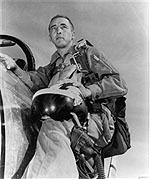Departed Fighter Pilot Leaves Lasting Impact on Air Force
 The nation lost a great hero with the passing of retired Air Force Brig. Gen. James Robinson “Robbie” Risner, Defense Secretary Chuck Hagel said today.
The nation lost a great hero with the passing of retired Air Force Brig. Gen. James Robinson “Robbie” Risner, Defense Secretary Chuck Hagel said today.
Risner, a highly decorated fighter pilot who served in World War II, the Korean War and the Vietnam War during his 30-year military career, died Oct. 22 at age 88 at his home in Bridgewater, Va., following a stroke.
Hagel said in a statement that he “was deeply saddened by the passing of Robbie Risner earlier this week, and my heart goes out to Dorothy and the entire Risner family.”
Hagel’s statement continued:
“I have known and admired Robbie for many years, and was always moved by his unwavering spirit and love of country. He served in the U.S. Air Force for more than 30 years -- seven of which he endured as a prisoner of war in Vietnam, facing relentless torture and extended periods of solitary confinement at the so-called Hanoi Hilton.
“Robbie's constant resistance in the face of his captors served as an inspiration not only to his fellow prisoners of war, but millions of Americans around the country. While our nation has lost a great hero, Robbie -- like all American prisoners of war -- will never be forgotten.”
During his military career, Risner had earned the Air Force Cross twice over, once for valor in aerial combat and again for gallantry after spending seven years as a prisoner of war.
After being stationed in Panama during World War II, Risner spent several years as a civilian. He returned to active duty in 1951, flying F-86E Sabre jets into combat against MiG-15s over Korea. He became a jet ace after shooting down five MiGs within four months of joining his combat unit. He ultimately flew 108 missions during the Korean War and downed a total of eight MiG-15s.
In one notable exploit, Risner chased a MiG 35 miles into China, hugging riverbeds and threading through hangars at a Chinese air base before finally shooting the plane down, where it crashed into a row of parked jets.
On the return flight, Risner’s wingman was hit and leaking fuel. To help him reach friendly territory, Risner inserted the nose of his aircraft into the tail of his wingman’s plane and pushed him out over the East China Sea. The wingman was able to bail out near a United Nations rescue base, but unfortunately drowned when he became entangled in his parachute lines.
During combat over North Vietnam, Risner earned his first Air Force Cross after leading two missions to destroy a strategically important bridge. The ensuing air battle marked the first time U.S. jets fought against the MiG-17 and led to significant changes in Air Force doctrine. Risner was featured on the April 23, 1965, cover of Time magazine following the battle.
The first time Risner was shot down by the North Vietnamese, on March 16, 1965, he was rescued after bailing out over the Gulf of Tonkin. Six months later, he was shot down again and captured.
During his time as a prisoner, Risner served as the senior officer at Hoa Lo Prison -- the infamous Hanoi Hilton -- and as the vice commander of the 4th Allied POW Wing.
In an article for Air Force News Service, Gen. Mark A. Welsh III, the Air Force chief of staff, described the events that unfolded after Risner organized a forbidden church service.
“As their captors led Risner away, Col. “Bud” Day and the more than 40 other POWs in the room began singing “The Star-Spangled Banner” to show their support. Hearing the defiant singing, Risner walked away with his back straight, head held high, full of pride.
“When asked later how he felt at that moment, Risner said, ‘I felt like I was 9 feet tall and could go bear hunting with a switch.’ That moment and his words are reflected by a statue, exactly 9 feet high, that now stands at the U.S. Air Force Academy. “Bud” Day spoke at the unveiling of the statue, saying, ‘We knew he was, in fact, 9 feet tall. This is a life-size statue.’”
Risner spent seven years as a POW in North Vietnam -- three in solitary confinement - before being released in 1973. He retired from the Air Force in 1976.
He later authored a book about his experiences, “The Passing of the Night: My Seven Years as a Prisoner of the North Vietnamese.”